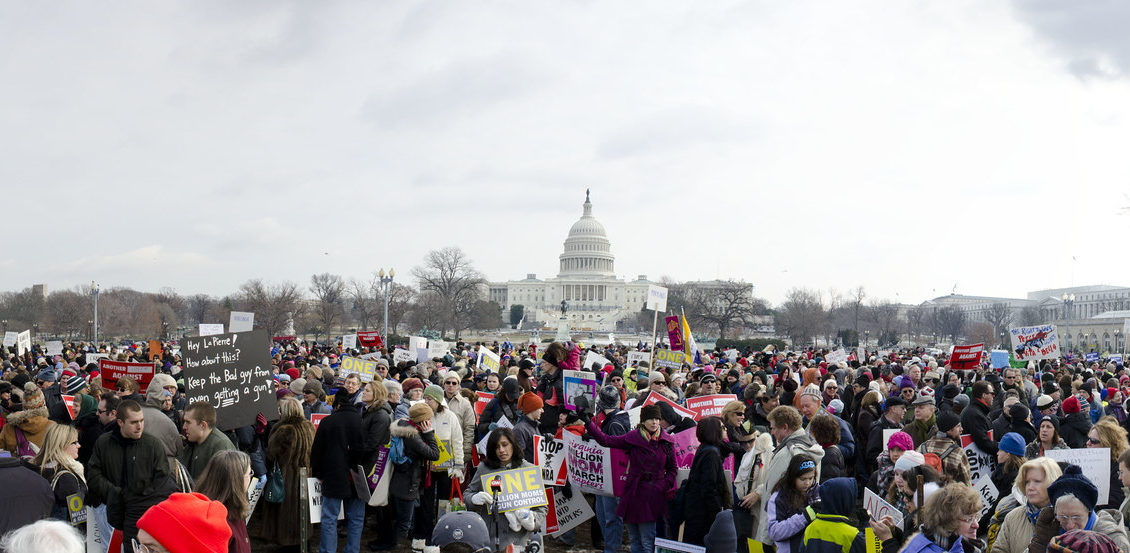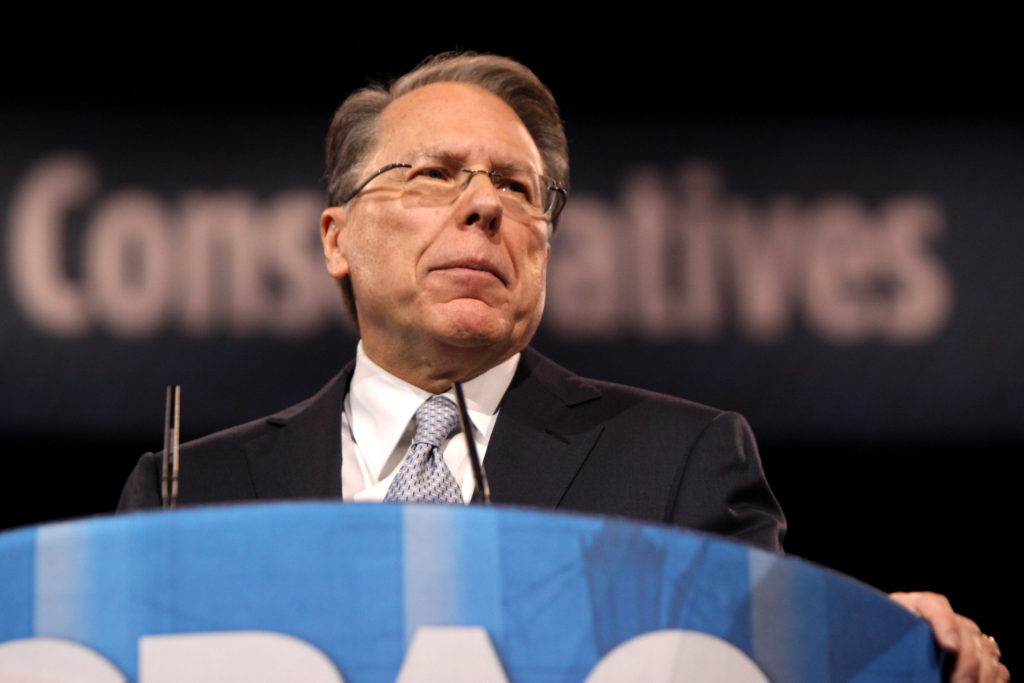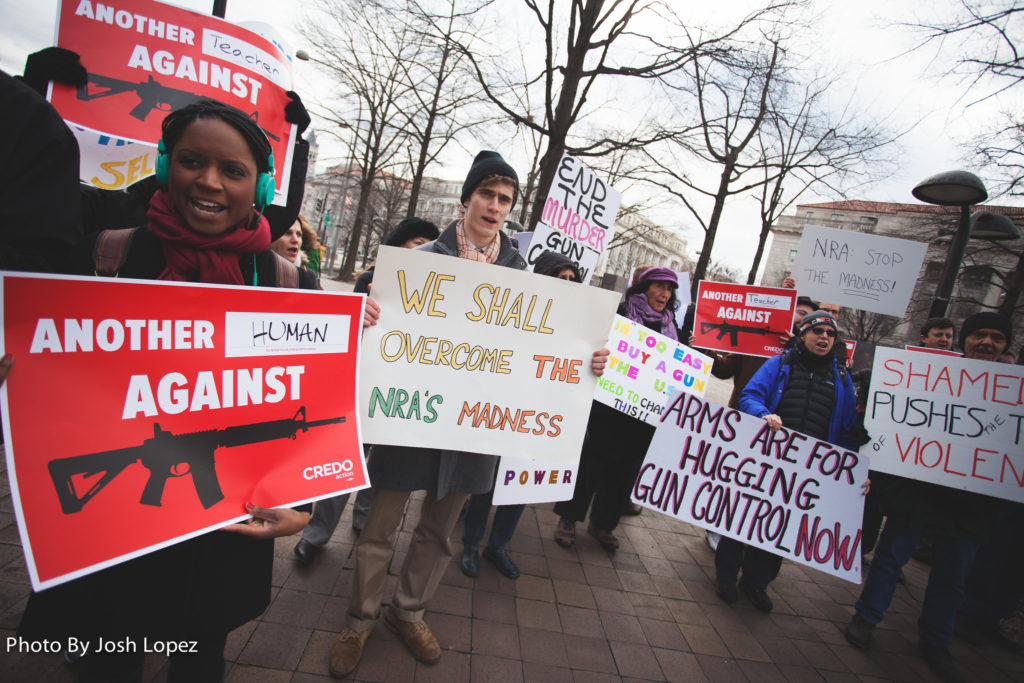The N.R.A.: Is The Reign Finally Over?
 "Gun Control March" by Blink O'fanaye is licensed under CC BY-NC 2.0. https://flic.kr/p/dQpJdy
"Gun Control March" by Blink O'fanaye is licensed under CC BY-NC 2.0. https://flic.kr/p/dQpJdy
Speaking on the political power of the National Rifle Association (N.R.A.) in the United States, journalist Robert Draper remarked that, “at a certain point, political mythology engineers its own reality.” PBS called it “the best-equipped, most-feared special interest group on Capitol Hill” – the gold standard of lobby groups. Former President Clinton named the N.R.A. as the reason the Republicans flipped both houses of Congress during his presidency in 1994, in backlash to his assault weapons ban. After decades of holding this formidable reputation in American politics, the N.R.A. might finally being slipping in influence.
The Power of the N.R.A.
Quantifiable or not, for decades, the N.R.A. has been able to exercise an incredible amount of power in the name of the gun rights, especially considering its status as a non-profit. In recent years, during the aftermath of the Sandy Hook tragedy, they mobilized voters and pressured Congressmen in order to ultimately defeat Senator Joe Manchin’s bill for universal background checks, turning on their own member and A+-rated candidate. The organization contributes tens of thousands of dollars every cycle to Congressional campaigns for candidates who share their views and went on to block over one hundred gun-related federal actions or policies since the Sandy Hook shooting. In 2016, the N.R.A. spent a whopping $412.7 million, including $30 million on the Trump campaign alone.
To put this power in perspective, Business Insider reports that since 2013, the N.R.A. has spent nearly ten times as much as the largest gun control lobbying group in the country. Compared to the American Civil Liberties Union, a non-profit group with a similar lobbying reach and name recognition, the N.R.A. has a budget that is three times larger. With less than five million members representing not even a fifth of American gun owners, the N.R.A. builds on its membership revenue with large outside donations and high-profile sponsorships through NRATV, national events, and other publications. In addition to wielding financial power, the organization is famous for having an especially active and loyal voting base, responding to N.R.A. candidate ratings and advertising campaigns through grassroots political action. The organization’s communications strategy has found particular success, through widespread attack ads against opposition candidates and incumbent leaders seen to be encroaching on gun rights.

As a retired Congressman from a conservative district explained: “That was the one group where I said, ‘As long as I’m in office, I’m not bucking the N.R.A.’” However, recent developments, both inside and outside the organization’s inner circle, appear to pose a threat to this vast political tenure.
A Crisis in Leadership
Recent tax filings reveal that the N.R.A. is running a deficit. After a steady climb in annual expenditures over the past decade that culminated in an all-time high in 2016, revenue remains stagnant in comparison, failing to even match the annual inflation rate in yearly increases. As a result, the organization recorded a $31.8 million deficit in 2017.
Having kept this largely out of the public eye for years, the first signs of financial strain emerged in 2018. While mid-term elections were hotly-contested across the country, N.R.A. campaign spending was vastly down. The F.E.C. recorded $9.7 million in federal campaign contributions, which is only a third of what the organization spent during the 2014 mid-term election season. Not only was spending down, but election spending by gun control groups had skyrocketed to around $20 million in the same cycle.
The NRA spent $9.7 million this year to defend Republicans' complete control of Washington—⅓ of what it spent on the 2014 midterms. More stats from 2018: https://t.co/t7yhXL4PJz pic.twitter.com/plvfnBO5Qr
— The Trace (@teamtrace) December 26, 2018
While gun-control lobby spending increased and many of the 2018 mid-term elections were hotly contested, N.R.A. spending was vastly down from the previous mid-term cycle.
The organization’s financial woes came to a head this year in the form of a dramatic power struggle. President Oliver North launched an internal campaign against Executive Vice President and CEO Wayne LaPierre in April, over alleged financial mismanagement. This escalation came on the heels of an internal audit that resulted in a financial law suit against Ackerman McQueen, a longstanding advertising partner – and employer of North. A widespread coup attempt ensued, as North, a powerful in-house attorney, the organization’s top lobbyist, several board members, several donors, and Ackerman McQueen coordinated to blackmail LaPierre into resigning. After the extortion attempt failed, the rift went public when North resigned ahead of the N.R.A.’s national conference in Indianapolis, but not without leaking accounts of the exorbitant spending by LaPierre and other board members.
The revolt rippled throughout the inner circle. The fallout from the plot continues as more leaders – such as top lobbyist Chris Cox – resign, or forcibly do so. A group of wealthy donors are holding their own revolt, threatening to withhold more than $134 million in pledges should the Association fail to resolve the internal warfare and find efficient leadership. Many Republican candidates for the 2020 elections have publicly admitted their doubts in the organization. A close advisor and fundraiser for Senate Majority Leader Mitch McConnell revealed three weeks ago that the campaign is gearing up to compensate for low N.R.A. funding this cycle. Many more candidates inside Republican leadership share that view, voicing concerns – albeit, often anonymously to the press – about lack of trust in N.R.A. leadership, strategy, and campaign attentiveness. A Republican close to the White House reported that even President Trump had informed aides that the N.R.A. was “vulnerable” and on the verge of being “bankrupt.”
Increasingly Under Attack
Evidently, not only are N.R.A. finances weakening, but so is confidence in the organization. This crisis of confidence is seemingly matched by external forces, too. Compounding its decreased election spending is the rise in recent public opposition to N.R.A. causes.
State legislators have found new support in publicly taking on the Association. New York’s Democratic Attorney General Letitia James was elected in 2018 on a platform of investigating the N.R.A.’s tax-exempt status, and she launched her official investigation into the organization’s finances in April of this year. Washington D.C. Attorney General Karl Racine launched a similar investigation in his district three months later. While the N.R.A. was chartered in New York and thus is under state purview there, this most recent investigation in D.C. pertains to the organization’s charity arm, the N.R.A. Foundation, which was created in the capital. The Foundation has already faced fire since potential ties to Russia have been subject to recent Congressional inquiry. It was even declared a “Domestic Terrorist Organization” by the City of San Francisco last month.

By the end of 2018, favorable public opinion of the N.R.A. had dropped below 50 percent for the first time since 1997. The favorability rating has since dropped another 7 points this year alone, according to a recent Fox News Poll. In a particularly interesting data analysis, New York Times journalist Maggie Astor found that this trend of declining public opinion was even reflected in Congress. By analyzing the N.R.A. politician rating system, Astor found that the organization had been assigning fewer A-ratings and more F-ratings in Congress steadily since the 2008 election. This is a huge indicator of declining support for the cause. Her analysis shows that voters did not punish candidates who “defected” or were assigned lower ratings; in fact, they did better electorally if they moved away from the N.R.A.
Looking to 2020
There is no denying the fact that N.R.A. support has increasingly becoming a highly partisan issue. Pew Research Center found that Democrats are less likely to belong to the N.R.A., more likely to support a candidate who supports gun control, and more likely to hold the view that the N.R.A. has too much influence over gun legislation. This general trend has only sharpened as progressively fewer Democrats hold A – or even B or C – N.R.A. ratings in Congress. However, the organization still holds very public power over the policies of the current President.
While past mass shooting incidents have often resulted in an immediate spike in N.R.A. membership and funds – due to gun rights-related panics – this has notably not been the case in 2018 and 2019. In fact, students of the Stoneman Douglas school in Florida started publicizing a #NoNRAMoney campaign in 2018 to hold legislators accountable for accepting N.R.A. funding and to urge voters to cut support for the candidates who do accept these funds. Far from a post-shooting backlash, the gun control lobby is gaining power and momentum. Gun control remains a central issue for the upcoming election cycle, and judging by its performance in 2018, the gun control lobby is only increasing its spending and influence.
Having adapted well to the political realm over many years, the question is whether the N.R.A. will withstand this new challenge. While the #NoNRAMoney pledge remains strong this year and N.R.A.-funded candidates seem to be facing some backlash online, no true polling data is available on its effects going into the 2020 election. With only the first glimpses of a quantifiable decline in the N.R.A.’s influence during the 2018 mid-term elections, only time will tell if this is the beginning of the end of the N.R.A.’s reign as top dog in American elections. But with a crisis of confidence coming from all sides – even from its most ardent organizational leaders and political partners – the curtain is certainly being pulled back, leaving the myth exposed.
Edited by Natalie Gastevich.
